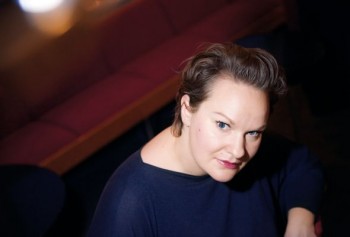Love and marriage
31 October 2013 | Authors, Interviews

Sanna Tahvanainen. Photo: Cata Portin
Victoria, a lonely, restricted child, grows up to be a mother of nine; in the eyes of the world, she is enormously powerful. The love she feels for her husband is equally strong. In constant, troubled search of herself as a woman, Victoria lives a long life.
Sanna Tahvanainen’s character is a queen – but her novel, Bär den som en krona (‘Wear it like a crown’, 2013) a surprising, rich portrait of a woman, is almost completely lacking in descriptions of Victoria’s regal duties. This extract is set at the opening of the London International Exhibition of Industry and Art in 1851. Janina Orlov interviews the author.
JO: How did you decide on Queen Victoria? I remember you once commented that you only had a very general picture of her, but once you started rooting around you must have found a wealth of information.
ST: I didn’t make any sort of concrete decision to write a book about her; she fascinated me in a peculiar way. I would return to her every time I was working on a new collection of poetry; I’d already written so much poetry that there was almost a hint of routine about it all, this was something I could really get my teeth into. Because we know so little about Victoria’s childhood, I actually had quite a lot of freedom. Of course, there are reams of books about her! But I’ve never found a novel about her.
JO: How did you go about creating her voice?
ST: I read a couple of deathly dreary books about Victoria and gave up several times. It was mostly only politics and things that didn’t interest me in the least. All the delicious little details were brushed aside in appendices. Then I happened upon the book We Two by Gillian Gill, which focuses largely on how the relationship with Albert affected Victoria, and vice versa. The books about her by Lytton Strachey and Edith Sitwell have also been important.
Finding her voice was painstaking and took me a long time – I thought how absurd it was that I of all people should be writing a book from Victoria’s perspective. Who am I to do such a thing? I knew that Victoria’s diaries were available, but I decided not to use them in finding the tone of the book. I travelled to London, walked around rooms she had also walked around, looked at the bed in which she slept, her toys, her clothes. But when the voice finally came to me, there was no going back: the first person gives you such freedom! She became ‘I’, or rather I became a vessel for her. Many of the books I read about her were so tedious because they tried to distance themselves from her. I wanted to access the intimate, the forbidden. I wanted to get right inside her. Of course, her voice changed a lot on the way. The child becomes queen, then marries and becomes a mother herself, is widowed, and slowly ages.
JO: Now to Albert: there is a duality about the image of him we read – idolised by his wife, reviled by his newly acquired people. How did you find negotiating his character? Though Victoria narrates throughout, we see him through her: is there a love-power binary at work here?
ST: Albert, yes… I empathised with him rather a lot. He was Victoria’s poor little cousin, and initíally she was more interested in his older brother Ernest. But then Albert grew into a muscular, tall man, and this was important for Victoria. He was enormously cultured and, to top that all, very handsome. In many ways he was her polar opposite.
The relationship of love and power was in fact the doorway into this project. When I first caught sight of the enormous, golden Albert Memorial, a monument in itself, I was taken aback – it seems the taciturn queen knew something about passion after all. The sculpture is the proof of her adoring love. She herself stands outside Kensington Palace in modest marble form. I couldn’t help but think of the balance of power – their relationship was an ongoing power struggle, and nine pregnancies certainly took their toll on her. Victoria could not show herself in public when she was pregnant. This, meanwhile, represented career opportunities for Albert. Victoria retaliated and Albert retracted. She bought some land and asked him to build another castle, and with this they were reconciled. And so it continued.
JO: Humour is also an important element of the narrative; it lends the text a sense of playfulness. This is perhaps not what one would expect in a novel about a queen – how did you come up with this?
ST: Well, she is so endlessly amusing, absurdly funny! Humour is part of the text right from the start; indeed, the era itself seems to invite a certain humorous levity. I’m drawn to the kind of comedy that gets stuck in your throat. Victoria’s position and the power that brings with it opens the doors to a great deal of black humour too, such as when she suddenly decides to lock Albert out of Windsor Castle, then proceeds to enjoy his humiliation from behind the curtains.
Victoria… she still fascinates me. It’s like having a stone in your shoe. Eventually you have to take your shoe off and examine the stone.
Translated by David Hackston
No comments for this entry yet
Leave a comment
-
About the writer
Janina Orlov (born 1955), PhD, teaches literature at the Stockholm University, Sweden. She translates fiction from Finnish and Russian into Swedish.
© Writers and translators. Anyone wishing to make use of material published on this website should apply to the Editors.
